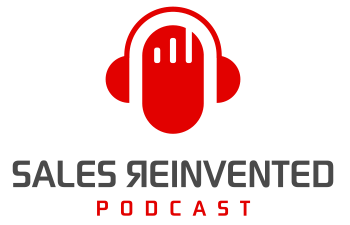Episode #423: Chris Cicconi

Meet
Chris Cicconi
Chris is a multi-time President’s Club winning salesperson who fell in love with leadership and developing others. Having been a multiple time founding salesperson, startup advisor and fractional leader gives him a unique view on the nuances of sales.
Our Mission Is To Change The Negative Perception Of Sales People
Our Vision Is A World Where Selling Is A Profession To Be Proud Of
Early in his career, Chris Cicconi believed cold-calling was a science. He came prepared with a script, knew everything about who he was talking to, and knew when to execute. But as his career has evolved, the process has become more of an art. Now he gathers a general idea of his persona, where they work, and what their industry is like but he doesn’t rely on the structure like he did in the past. He shares how his process helps him book more meetings in this episode of Sales Reinvented.
Outline of This Episode
- [0:46] What is cold-calling? Is it still relevant?
- [2:08] Is cold-calling an art and a science?
- [3:23] How Chris prepares for cold-calling
- [5:05] Chris’s effective opening lines and techniques
- [7:11] How to keep a cold call engaging
- [9:06] Indispensable tools, technology, and metrics
- [10:26] Chris’s top cold-calling dos and don’ts
- [15:57] How Chris handles objections and rejections
How Chris prepares for cold-calling
Chris can’t do cold-calling in small batches. He can’t just “sneak” it in. He breaks up his day and blocks off his calendar. He starts with the warmest calls first. He’ll call a current client or a follow-up first because there’s a better chance they’ll pick up the phone (and want to talk to him). That builds his confidence and warms up his voice. He leaves the “coldest” calls for the end.
Chris’s effective opening lines and techniques
Chris usually starts with a permission-based opener: “Hey this is Chris with x, I know I’m calling you out of the blue, do you have 30 seconds for me to explain the reason for my call.”
If he has a proven solution he’s offering, he’ll jump into a good question to get them talking: “I’m calling because I speak to a lot of HR leaders and they’re telling me this, how are you handling that in your organization?”
It’s all about starting a conversation to explain the value of your product or service. Ask questions that will lead them in the right direction, so you can explain how whatever you’re calling about solves their problem. Find the opportunity to book more time to speak further.
But always be prepared for when the answers don’t go in the direction you expect. You never know where things will lead!
Chris’s top cold-calling dos and don’ts
To Chris, the art of cold-calling starts with these tips:
- Be prepared—but don’t spend hours preparing. Know the persona you’re reaching out to and the industry they’re in to have the right challenges and objections top of mind.
- Fake it until you make it. Pretend you’re confident until you’re confident. Use the right tone, language, and cadence, and deliver your message clearly.
- Prepare yourself for the call. Grab water and whatever else you may need and get mentally focused and ready to go.
- Don’t be a jerk. When Chris was learning how to cold call, they emphasized over-asking for a meeting. Don’t be afraid to accept their no and move on. You have to intuitively feel whether or not to push forward. There are no hard and fast rules.
- Don’t be a robot. While you can start with scripted openers, you can’t script the whole process. Know how you’ll handle some objections. But don’t feel like you have to read a script. It doesn’t build engagement.
- Don’t think it’s only about booking the meeting. Who else could you talk to? What current solution do they use? What is their budget? What is their headcount?
Remember that there are other ways to get value out of a conversation.
How Chris handles objections and rejections
We don’t want to spit out irrelevant questions. Listen to what they say. If they don’t need something because of “x, y, or z” reason, you can reframe things.
Chris was on a phone call with a prospect and was getting shut down. They were using a competitor and happy with their service. Chris asked what they liked or didn’t like about their current provider.
They half-answered the questions. So Chris asked, “I understand what you’re saying. I’m just trying to offer you this solution. If you were in my shoes, how would you do that? Are you the right person to talk to?”
He painted things generically to find out if they were the decision-maker. This person said they were the person he’d need to talk to. He asked if they’d be open to taking some time to chat with him, look at the product, and give me feedback about how we’re approaching these conversations and demos.
Chris was able to book the meeting. And while he didn’t end up working with that particular client, it did lead to other referrals. Sometimes you have to pivot to see what else you can get from a call. You just have to pay attention enough to see it.
Resources & People Mentioned
Connect with Chris Cicconi
Connect With Paul Watts
Audio Production and Show notes by
PODCAST FAST TRACK
https://www.podcastfasttrack.com
Learn More About Chris Cicconi
What was a pivotal moment or experience in your career that shaped your approach to cold calling, and how did it change your perspective or strategy?
I had a sales leader explain that my approach to cold calling was literal insanity. Driving high volumes of calls, with a binary result – did I get the meeting or not?
It was repeating the same thing over and over and expecting a different result. When I took a different approach – that getting the meeting wasn’t the only positive result of a cold call, everything changed.
I was focusing on getting the most out of every conversation, whether that was a meeting, a referral, account information or even getting shut down in a way where I could fully disqualify an account – all of it valuable.
Can you share a specific tactic or approach you’ve used in cold calling that significantly increased your success rate? Please provide a brief example or case study.
The change in approach that has been the most impactful to me is when my calls became more casual. At first, I was busy being a cold calling robot – regurgitating a script, instead of being myself. When I began to take a more casual approach, just trying to have a conversation with the person on the other end of the line, things changed massively!
Cold calling often comes with its set of challenges and rejections. Can you share a particularly tough challenge you faced while cold calling and how you overcame it?
Dealing with rejection, when cold calling, is like building up callouses when learning to play the guitar. Do they suck? Sure. Are they painful? Most definitely. At a certain point though, you start to be bothered less and less by them – especially once you realize that there are other factors to take into account.
Did they say no to the meeting? Sure, but they told me they use a competitor, or they gave me a referral. Focus on the small wins.
Sales is a marathon and even baby steps continue to move you forward.
What are the top three tools or resources (e.g., software, books, training programs) you consider essential for someone looking to improve their cold calling skills and outcomes?
1) Trellus (Trellus.ai) is a tool that has helped me massively. First, it’s a power dialer that has allowed me to be more effective in making my calls, second, while it’s dialing, it serves me up a summary of who my prospect is and what their company does, third, it gives me in the moment feedback on my call. Am I talking too much? Too quickly? Even prompts me with questions I can ask if I get stuck. It’s made my whole process more streamlined.
2) This is going to sound silly – but I really don’t like any specific books or training programs, when it comes to cold calling. I find the majority of them too rigid. It teaches you one way that one person (or company) sees success in cold calling. I think there’s value there, but I would rather connect with different folks through networking and understand their best practices – then practice.
3) Any type of virtual sales floor OR (even better) calling with other people. Nothing beats both the energy and the coaching opportunity of being in person and calling with peers or partners. I firmly believe in a remote or hybrid work environment but there is still a great opportunity in being in person for cold calling.
How do you foresee the practice of cold calling evolving in the next few years with advancements in technology and changes in buyer behavior? What advice would you give to sales professionals to stay ahead of the curve?
Buyers want less sales interactions during their journey, than in the past. In part, that’s due to the amount of information they can access, as they can do a tremendous amount of legwork on their own. The future is going to continue to see more of that, so I truly believe, not just cold calling, but sales in general in the future, will be a lot more reliant on signals. Are folks looking at certain resources? Attending webinars? Downloading white papers? On your website? And you’ll have to gather all of this information to approach prospects & meet them where they’re at. Pure cold outbound will continue to be less and less effective.
Share This Episode, Choose Your Platform!
